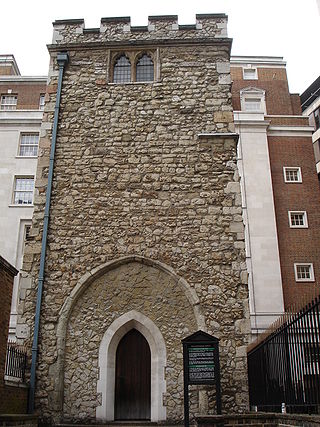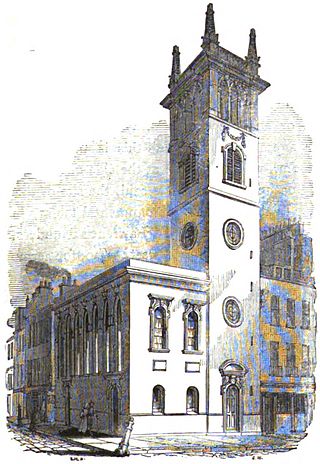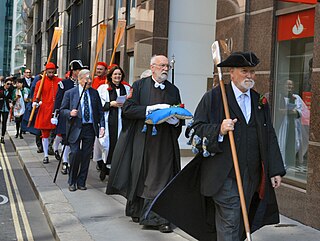
Samuel Pepys was an English diarist and naval administrator. He served as administrator of the Royal Navy and Member of Parliament and is most famous for the diary he kept for a decade. Pepys had no maritime experience, but he rose to be the Chief Secretary to the Admiralty under both King Charles II and King James II through patronage, diligence, and his talent for administration. His influence and reforms at the Admiralty were important in the early professionalisation of the Royal Navy.

St Olave's Church, Hart Street, is a Church of England church in the City of London, located on the corner of Hart Street and Seething Lane near Fenchurch Street railway station.

All Hallows Staining was a Church of England church located at the junction of Mark Lane and Dunster Court in the north-eastern corner of Langbourn ward in the City of London, England, close to Fenchurch Street railway station. All that remains of the church is the tower, built around AD 1320 as part of the second church on the site. Use of the grounds around the church is the subject of the Allhallows Staining Church Act 2010.

St Dunstan-in-the-East was a Church of England parish church on St Dunstan's Hill, halfway between London Bridge and the Tower of London in the City of London. The church was largely destroyed in the Second World War and the ruins are now a public garden.

St Alban's was a church in Wood Street, City of London. It was dedicated to Saint Alban. Of medieval origin, it was rebuilt in 1634, destroyed in the Great Fire of London in 1666, and rebuilt, this time to a Gothic design by Sir Christopher Wren. It was severely damaged by bombing during the Second World War and the ruins cleared, leaving only the tower.

All Hallows Bread Street was a parish church in the Bread Street ward of the City of London, England. It stood on the east side of Bread Street, on the corner with Watling Street. First mentioned in the 13th century, the church was destroyed in the Great Fire of London in 1666. The church was rebuilt by the office of Sir Christopher Wren and demolished in 1876.

All-Hallows-the-Great was a church in the City of London, located on what is now Upper Thames Street, first mentioned in 1235. Destroyed in the Great Fire of London of 1666, the church was rebuilt by the office of Sir Christopher Wren. All-Hallows-the-Great was demolished in 1894 when many bodies were disinterred from the churchyard and reburied at Brookwood Cemetery.

St Olave's Church, Old Jewry, sometimes known as Upwell Old Jewry, was a church in the City of London located between the street called Old Jewry and Ironmonger Lane. Destroyed in the Great Fire of London in 1666, the church was rebuilt by the office of Sir Christopher Wren. The church was demolished in 1887, except for the tower and west wall, which remain today.

St George Botolph Lane was a church off Eastcheap, in the ward of Billingsgate in the City of London. The rear of the church overlooked Pudding Lane, where the fire of London started. It was first recorded in the twelfth century, and destroyed in the Great Fire of 1666. It was one of the 51 churches rebuilt by the office of Sir Christopher Wren. The church was demolished in 1904.

St Martin, Ludgate, also known as St Martin within Ludgate, is an Anglican church on Ludgate Hill in the ward of Farringdon, in the City of London. The church is of medieval origin, but the present building dates from 1677 to 1684 and was designed by Sir Christopher Wren.

St Benet Gracechurch, so called because a haymarket existed nearby (Cobb), was a parish church in the City of London. First recorded in the 11th century, it was destroyed in the Great Fire of London of 1666 and rebuilt by the office of Sir Christopher Wren. The church was demolished in 1868.

The Worshipful Company of Parish Clerks is one of the Guilds of the City of London. It has no livery, because "in the 16th century, the Parish Clerks declined to take the Livery on the grounds that the surplice was older than the Livery and was the proper garb of members of the Company." It is not, therefore, technically a livery company although to all intents and purposes it acts as such. It is one of two such historic companies without livery, the other being the Company of Watermen and Lightermen.

St Michael, Crooked Lane, was an ancient parish church situated on the east side of Miles's Lane in Candlewick ward in the City of London. It was rebuilt after the Great Fire of London by Sir Christopher Wren, and demolished in 1831.

Tower is one of the 25 wards of the City of London and takes its name from its proximity to the Tower of London. The ward covers the area of the City that is closest to the Tower.

St Michael's Wood Street was a church and parish of medieval origin in Cripplegate Ward in the City of London, and is first mentioned in 1225 as St. Michael de Wudestrate. It stood on the west side of Wood Street, initially with a frontage on Huggin Lane but later on Wood Street itself.

St Mary Colechurch was a parish church in the City of London destroyed in the Great Fire of London in 1666 and not rebuilt.

Coldharbour, also spelled Cold Harbour, Cold Harborough, Cold Herbergh, Cold Herberge, and Cold Inn, were two London neighbouring estates in the since dissolved parishes of All-Hallows-the-Less and All-Hallows-the-Great, in today's Dowgate Ward of the City of London. From the 13th century to the mid-17th century Coldharbour occupied the area between Upper Thames Street and the Thames to the east of Cannon Street station. It was destroyed in the Great Fire of 1666. One of the estates was used by the Dukes of Exeter and briefly as a college of heralds.
Karin Margareta Jonzen, née Löwenadler, was a British figure sculptor whose works, in bronze, terracotta and stone, were commissioned by a number of public bodies in Britain and abroad.

The Knollys Rose Ceremony is an annual event led by the Company of Watermen and Lightermen. The ceremony dates to 1381 and is held each year in June. A single red rose is snipped from the garden in Seething Lane, placed on an altar cushion from All Hallows-by-the-Tower and carried in procession west to the Mansion House where it is presented to the Lord Mayor of London.

Hart Street is a small street in the City of London.





















